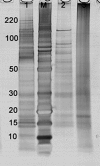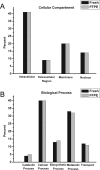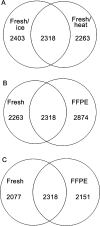Pressure-assisted protein extraction: a novel method for recovering proteins from archival tissue for proteomic analysis
- PMID: 22352854
- PMCID: PMC3320745
- DOI: 10.1021/pr201005t
Pressure-assisted protein extraction: a novel method for recovering proteins from archival tissue for proteomic analysis
Abstract
Formaldehyde-fixed, paraffin-embedded (FFPE) tissue repositories represent a valuable resource for the retrospective study of disease progression and response to therapy. However, the proteomic analysis of FFPE tissues has been hampered by formaldehyde-induced protein modifications, which reduce protein extraction efficiency and may lead to protein misidentification. Here, we demonstrate the use of heat augmented with high hydrostatic pressure (40,000 psi) as a novel method for the recovery of intact proteins from FFPE mouse liver. When FFPE mouse liver was extracted using heat and elevated pressure, there was a 4-fold increase in protein extraction efficiency, a 3-fold increase in the extraction of intact proteins, and up to a 30-fold increase in the number of nonredundant proteins identified by mass spectrometry, compared to matched tissue extracted with heat alone. More importantly, the number of nonredundant proteins identified in the FFPE tissue was nearly identical to that of matched fresh-frozen tissue.
Figures




Similar articles
-
Complete solubilization of formalin-fixed, paraffin-embedded tissue may improve proteomic studies.Proteomics Clin Appl. 2013 Apr;7(3-4):264-72. doi: 10.1002/prca.201200031. Epub 2013 Mar 6. Proteomics Clin Appl. 2013. PMID: 23339100 Free PMC article. Review.
-
Improving the Proteomic Analysis of Archival Tissue by Using Pressure-Assisted Protein Extraction: A Mechanistic Approach.J Proteomics Bioinform. 2014 Jun 24;7(6):151-157. doi: 10.4172/jpb.1000315. J Proteomics Bioinform. 2014. PMID: 25049470 Free PMC article.
-
Elevated pressure improves the extraction and identification of proteins recovered from formalin-fixed, paraffin-embedded tissue surrogates.PLoS One. 2010 Dec 8;5(12):e14253. doi: 10.1371/journal.pone.0014253. PLoS One. 2010. PMID: 21170380 Free PMC article.
-
Equivalence of protein inventories obtained from formalin-fixed paraffin-embedded and frozen tissue in multidimensional liquid chromatography-tandem mass spectrometry shotgun proteomic analysis.Mol Cell Proteomics. 2009 Aug;8(8):1988-98. doi: 10.1074/mcp.M800518-MCP200. Epub 2009 May 24. Mol Cell Proteomics. 2009. PMID: 19467989 Free PMC article.
-
Toward deciphering proteomes of formalin-fixed paraffin-embedded (FFPE) tissues.Proteomics. 2012 Apr;12(7):1045-58. doi: 10.1002/pmic.201100550. Proteomics. 2012. PMID: 22318899 Free PMC article. Review.
Cited by
-
Complete solubilization of formalin-fixed, paraffin-embedded tissue may improve proteomic studies.Proteomics Clin Appl. 2013 Apr;7(3-4):264-72. doi: 10.1002/prca.201200031. Epub 2013 Mar 6. Proteomics Clin Appl. 2013. PMID: 23339100 Free PMC article. Review.
-
Molecular Mapping Alzheimer's Disease: MALDI Imaging of Formalin-fixed, Paraffin-embedded Human Hippocampal Tissue.Open Neurol J. 2016 Sep 30;10:88-98. doi: 10.2174/1874205X01610010088. eCollection 2016. Open Neurol J. 2016. PMID: 27843502 Free PMC article.
-
Comparative evaluation of two methods for LC-MS/MS proteomic analysis of formalin fixed and paraffin embedded tissues.J Proteomics. 2021 Mar 20;235:104117. doi: 10.1016/j.jprot.2021.104117. Epub 2021 Jan 14. J Proteomics. 2021. PMID: 33453434 Free PMC article. Review.
-
A Highly Sensitive Indirect Enzyme-Linked Immunosorbent Assay (ELISA) Based on a Monoclonal Antibody Specific to Thermal Stable-Soluble Protein in Pork Fat for the Rapid Detection of Pork Fat Adulterated in Heat-Processed Beef Meatballs.Food Sci Anim Resour. 2023 Nov;43(6):989-1001. doi: 10.5851/kosfa.2023.e55. Epub 2023 Nov 1. Food Sci Anim Resour. 2023. PMID: 37969326 Free PMC article.
-
In-Depth Mass Spectrometry-Based Proteomics of Formalin-Fixed, Paraffin-Embedded Tissues with a Spatial Resolution of 50-200 μm.J Proteome Res. 2022 Sep 2;21(9):2237-2245. doi: 10.1021/acs.jproteome.2c00409. Epub 2022 Aug 2. J Proteome Res. 2022. PMID: 35916235 Free PMC article.
References
-
- Mallick P.; Kuster B. Proteomics: a pragmatic perspective. Nat. Biotechnol. 2010, 28 (7), 695–709. - PubMed
-
- Shi S.-R.; Liu C.; Balgley B. M.; Lee C.; Taylor C. R. Protein extraction from formalin-fixed, paraffin-embedded tissue sections: quality evaluation by mass spectrometry. J. Histochem. Cytochem. 2006, 54 (6), 739–43. - PubMed
-
- Ostasiewicz P.; Zielinska D. F.; Mann M.; Wisniewski J. R. Proteome, phosphoproteome, and N-glycoproteome are quantitatively preserved in formalin-fixed paraffin-embedded tissue and analyzable by high-resolution mass spectrometry. J. Proteome Res. 2010, 9 (7), 3688–700. - PubMed
-
- Hood B. L.; Darfler M. M.; Guiel T. G.; Furusato B.; Lucas D. A.; Ringeisen B. R.; Sesterhenn I. A.; Conrads T. P.; Veenstra T. D.; Krizman D. B. Proteomic analysis of formalin-fixed prostate cancer tissue. Mol. Cell. Proteomics 2005, 4 (11), 1741–53. - PubMed
-
- Patel V.; Hood B. L.; Molinolo A. A.; Lee N. H.; Conrads T. P.; Braisted J. C.; Krizman D. B.; Veenstra T. D.; Gutkind J. S. Proteomic analysis of laser-captured paraffin-embedded tissues: a molecular portrait of head and neck cancer progression. Clin. Cancer Res. 2008, 14 (4), 1002–14. - PubMed
Publication types
MeSH terms
Substances
Grants and funding
LinkOut - more resources
Full Text Sources
Other Literature Sources

